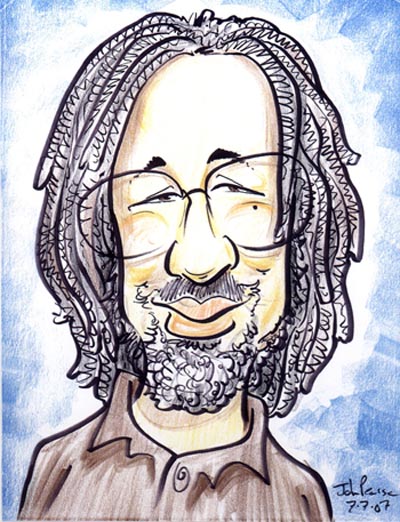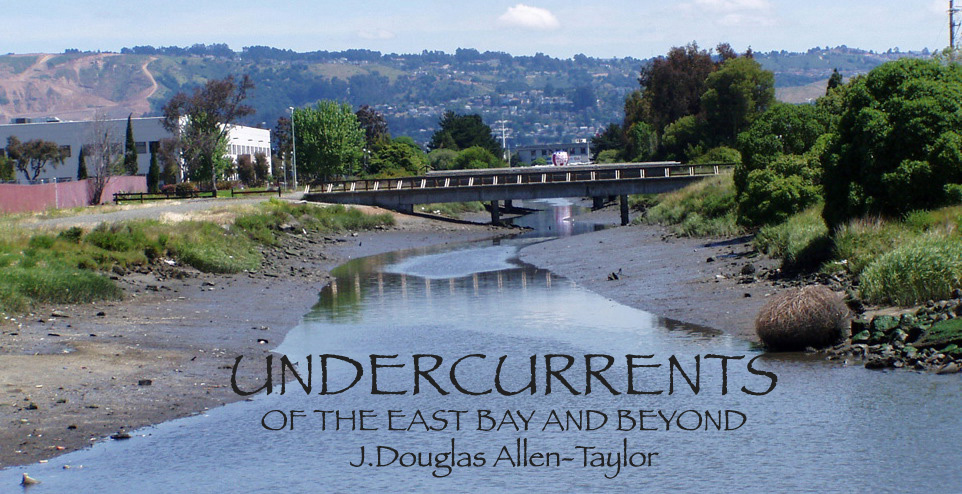|
|
CLOSING OAKLAND'S BLUE GAP
February 15 , 2008
We have come to an odd turn in Oakland’s Police and Crime and Politics novel, as if a master storyteller—Arthur Conan Doyle or Scott Turow, perhaps—has suddenly introduced an unexpected twist that makes the reader have to throw out many earlier assumptions, and even go back and revisit some of the first few chapters to see exactly how this spot was reached. We are in the middle of the story, now, so it is difficult to sort out all the narrative threads. I will do my best and if I err, forgive me, as this is being done as things are still developing, and new information is coming forth.
Oakland’s struggles to overcome its entrenched crime problems long ago divided it into two opposing political camps, one camp believing that the emphasis ought to be on cracking down on criminals and shoring up police resources, another that crime should be nipped earlier by violence prevention interventions. Most of the proponents on either side believed that Oakland ought to have some of both solutions—the division was over which solution ought to predominate and get the most attention and resources.
These battles revolved around various Oakland ballot measures that tilted between one side or the other—former Mayor Jerry Brown’s 2002 hire-100-more-police Measure FF and its related tax increase fundings, all of which lost, Councilmember Nancy Nadel’s 2004 Measure R parcel tax to raise money for violence prevention exclusively, which also lost, and, finally, Measure Y, which funded the hiring of 63 new police officers as well as various violence prevention programs.
Two of the Oakland Councilmembers who have been most vocal about the need for more police have been Council President Ignacio De La Fuente and District 7 Councilmember Larry Reid, who chairs the Council’s Public Safety Committee. De La Fuente signed the ballot argument against Nadel’s Measure R, saying in the argument, in part, that “the likely result [of the measure] is a grab bag of "pork-barrel" projects, each spending money on its separate administration with no coordination among them.” And while Reid supported the violence prevention measure, he told the Tribune in February of 2004 that Measure R "doesn't get us to where we need to be” in regard to increased police to combat Oakland’s crime.
Measure Y passed in November of 2004 and the city began collecting the authorized additional parcel tax money shortly afterwards. But while the measure authorized an increase of Oakland police strength to 803, the force has never come up to that full strength. Police staffing currently runs roughly 75 short, a fact that has led to increasing discontent among some Oakland residents during the current spike in city crime.
There are logistical difficulties in meeting that 803 full-strength target, among them that police retirements are outstripping recruitment, among others, and a plan was needed to close Oakland’s “blue gap.” Increased recruiting is not enough. But if the two Oakland Councilmembers most identified with increasing the numbers of police—Council President De La Fuente and Public Safety Chair Larry Reid—developed and advanced such a plan between 2005 and today, I haven’t seen it. If they did develop such a plan, I hope someone sends it to me. I don’t want to misrepresent.
Meanwhile, Oakland residents elected a new mayor in 2006, Ron Dellums. And increasingly, during his first year of office in 2007, Mr. Dellums has come under public criticism for not reducing Oakland’s crime rate. When some of those critics have not been painting Mr. Dellums with a broad “do-nothing mayor” brush, they have specifically charged that he is soft-on-crime, too philosophically addicted to violence prevention to take the tough-on-criminals stance that these critics feel Oakland needs.
But now come the twists in the narrative, which show that the lines on this issue are not as clear-cut as some critics—and many of my colleagues in the press—are representing.
In September of 2007, at a Town Hall citizens meeting at DeFremery Park in West Oakland, Mr. Dellums said he would like to reorganize how the Measure Y violence prevention money was being allocated, saying that parceling it out to various organizations “was like going in 100 directions all at once.” Asked if that meant he was going to embrace the existing Measure Y violence prevention funding or set his own priorities, Mr. Dellums responded that “a lot of the money is going to different agencies that are not properly coordinated. We should not just be funding programs. We need to fund a violence prevention strategy.”
That sounded remarkably like the “each spending money on its separate administration with no coordination among them” criticism Mr. De La Fuente endorsed three years before in the anti-Measure R ballot argument.
So does that mean Mr. Dellums and Mr. De La Fuente have come to a meeting of minds concerning combating crime in Oakland? Hardly. In fact, recent events seem to indicate that they have flown right past each other to the opposite sides of the argument.
At his State of the City address last month, Mr. Dellums made a surprise announcement—a pledge to end the Oakland police “blue gap” and bring the department up to full 803 strength by the end of the year. Many—myself included—criticized that pledge, not because we did not want to fully staff the Oakland police at authorized strength, but because we did not see, given the logistical problems, how that was going to be possible in the 11 months remaining in the year.
During his Oakland Convention Center speech, Mr. Dellums outlined a brief laundry list of what he called eight “approaches” to closing the “blue gap.” This week, the mayor and Police Chief Wayne Tucker fleshed out that list with a 21 page Augmented Police Recruitment Proposal, requesting that Council authorize the transfer of $7.7 million in Measure Y money to fund an accelerated police recruitment program. The mayor and chief appear to be requesting that the money come from the police services fund balance portion of Measure Y—which has been steadily growing as new taxes are collected and the promised new police officers have not been hired—and not from the violence prevention programs portion. In its semiannual February report, the Measure Y Oversight Committee has estimated that unspent police services carryover money at $8.6 million and growing, more than enough to cover the $7.7 million recruiting proposal request. Council is scheduled to take their first formal look at the augmented recruitment proposal at their February 19th meeting.
You would think that such a proposal would have tickled to death the two Councilmembers who have, in the past, been most vocal in support of increasing the numbers of police on Oakland streets. But both Council President De La Fuente and Council Public Safety Chair Reid seemed, strangely, underwhelmed and disconcerted.
In an article in Thursday’s Oakland Tribune entitled “Police Funding Request Draws Ire,” Mr. De La Fuente and Mr. Reid appeared to focus on process rather than substance. The augmented police recruitment proposal bypasses vetting in the Council Public Safety Committee, which Mr. Reid chairs, and is scheduled without full input from the Measure Y Oversight Committee, which canceled two meetings in a row because it fumbled its public notice requirements.
"The latest proposal from Mayor Dellums regarding Measure Y funds gives us more reason than ever to have the committee meeting and doing analysis," the Tribune quoted Mr. De La Fuente in response. And saying that the police recruitment proposal should be vetted by the public safety and Measure Y oversight committees before it goes to full council, the Tribune quoted Mr. Reid as saying, "It may upset the mayor, but I think there's a process we've got to follow. Certainly, I don't want to circumvent that process."
In rebuttal, Dellums Chief of Staff David Chai was quoted as saying that the vetting process “takes time,” and that ”every day we can't utilize our efforts to recruit (more officers) is a day lost. The clock is ticking. We have an ambitious goal that the mayor laid out and we're going to make that goal."
Let’s try to sort some of this out, with the handicap that we can only work on the information currently available.
Mr. Chai’s remarks appear ill-considered, and ought to be amended if not outright withdrawn. If Oakland had suffered a massive earthquake and Council was blocking emergency teams getting out to injured citizens, Council would need a public kick in the ass, and the mayoral chief of staff’s comments would be entirely appropriate.
However, although Oaklanders are dying and getting mugged in the city’s streets, nothing in the augmented recruitment proposal would have an immediate effect on those problems. The proposal’s own four stated goals say are to ”increase the pool of applicants and the number of new Police Officer Trainees entering the academy in 2008, increase the success rate of [trainees] in the academy, field more fully trained and qualified police officers on the streets of Oakland, and grow Oakland's own pool of qualified applicants for the future.”
Given that it might take only an extra two weeks to a month for a full Council Public Safety Committee and Measure Y Oversight Committee vetting, and given the fact that the Public Safety Committee is full of Councilmembers who have long commitments to increasing the number of Oakland police, and given the fact that the first recommendation in the oversight committee’s February semiannual report is to “immediately hire all 63 officers mandated by Measure Y,” it is difficult to see how the Public Safety and Measure Y Oversight committees will be a roadblock to the mayor and police chief’s recruitment proposals. And if the two committees are dissatisfied with the proposals, it is more likely that their dissatisfaction would lead to the full Council rejecting the proposals if the two committees don’t get their chance, first, to air out their concerns.
On the other hand, there may be no small measure of politics in the somewhat tepid initial response of Mr. De La Fuente and Mr. Reid. As we said, Council, after all, came up with no adequate plan on its own to close the “blue gap” between the time the gap became apparent sometime in early 2006 and today. For the supposed “soft-on-crime” mayor to advance such a plan over more “law-and-order” Councilmembers may be something of a political embarrassment to those Councilmembers. And so the squabble over process, rather than policy substance.
The truth is, it was Mr. Dellums himself who boxed his administration in a political corner by pledging the full 803 by the end of the year. But it’s a hollow box. If, at the end of the year, the augmented recruitment proposal is in place and there is substantial progress at closing the “blue gap,” only the most anal-retentive, or those who have a political interest in Mr. Dellums’ failure on any and all issues, will notice that the pledge was not met on time. The rest of Oakland will say that it’s about time, and won’t care about the rest of the rhetoric.
|

